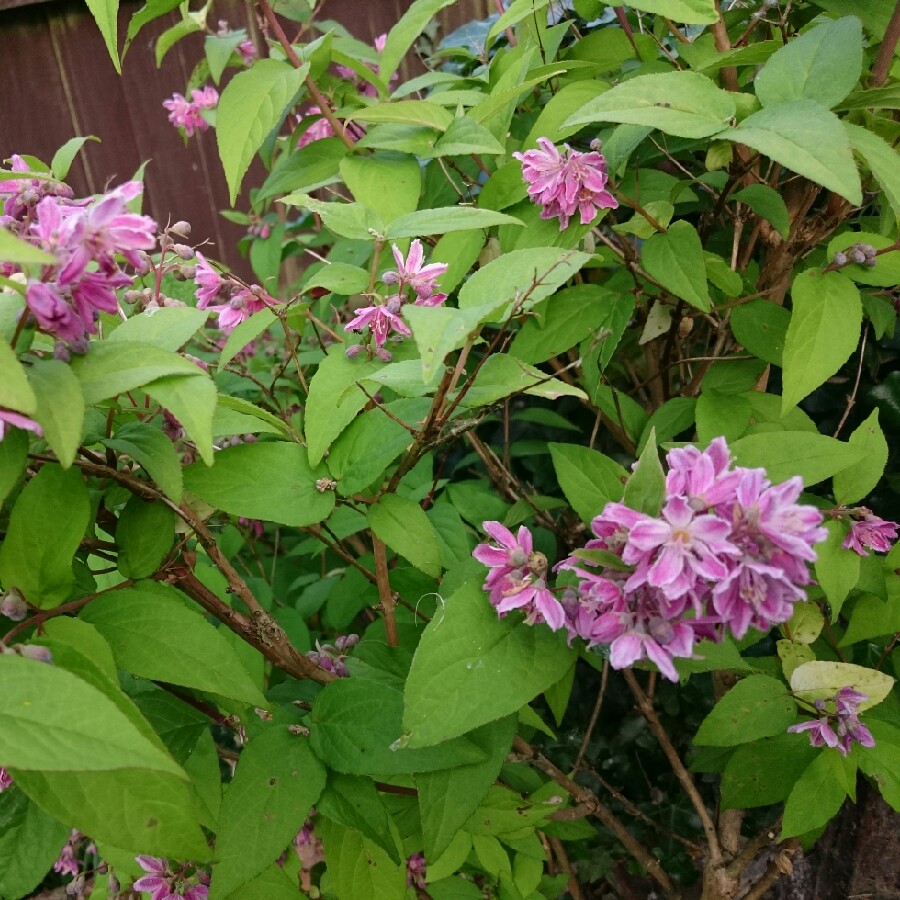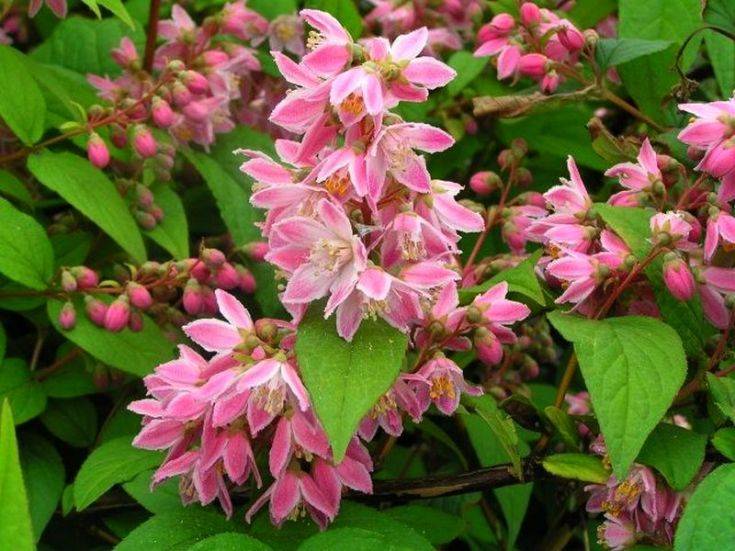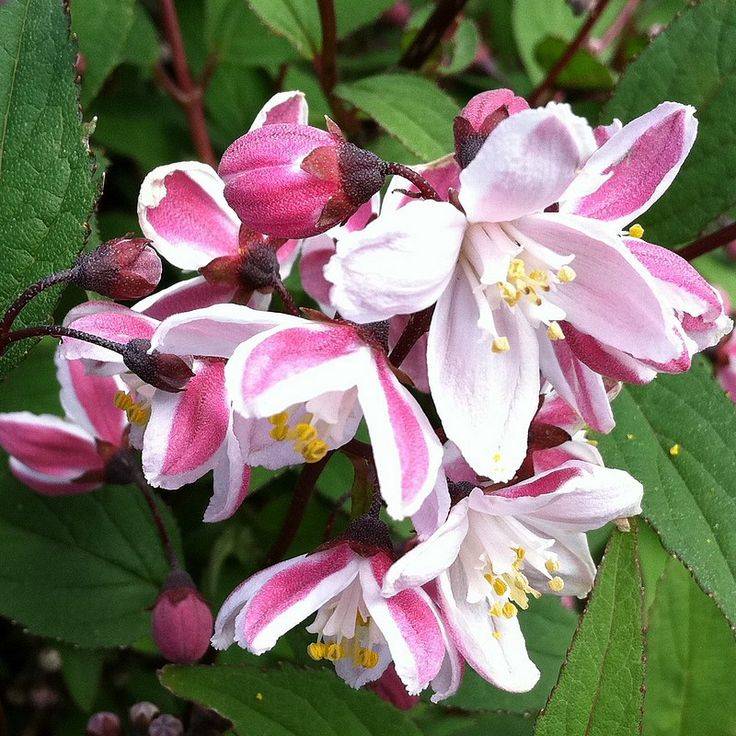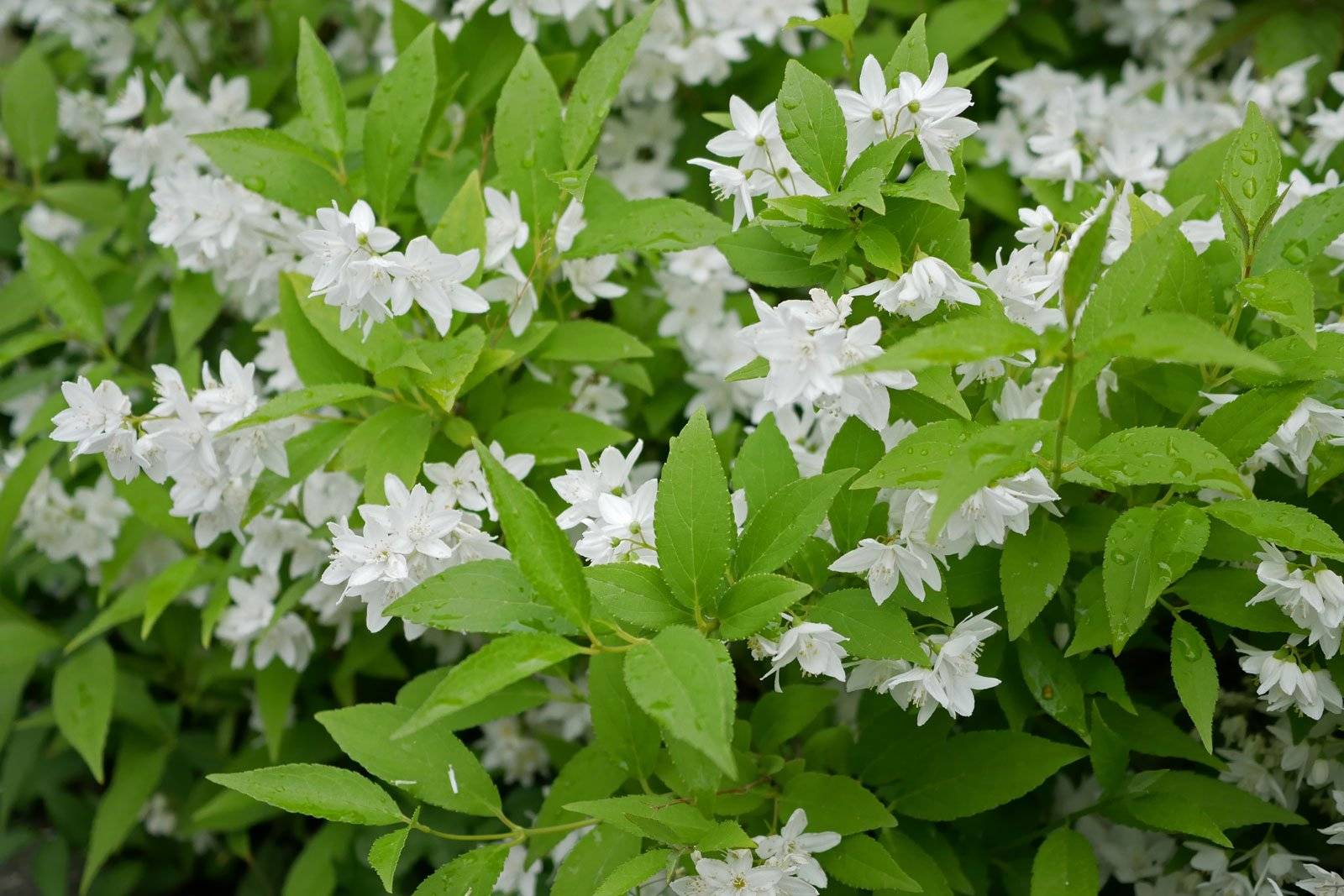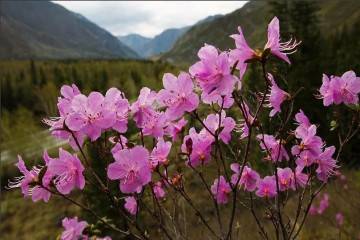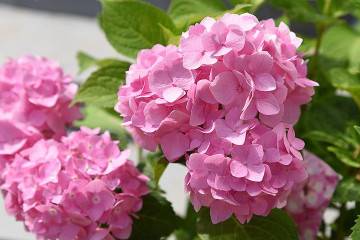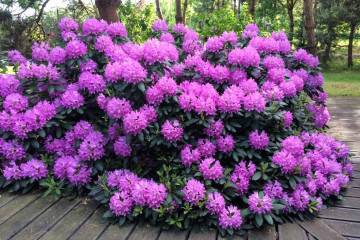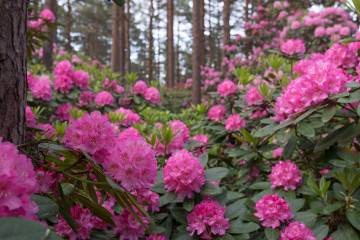Rough and white action - decorative shrub
Content:
Deytsia is a perennial deciduous shrub of the Hortensia family with a height of 0.5 to 4 m, depending on the variety. The main distinguishing feature of this shrub is the abundant and long flowering in late spring - early summer. The flowers are bisexual, connected in inflorescences in the form of a cone or ball, can be white, pinkish or purple-purple hues and are practically devoid of aroma. Outwardly, a flowering bush looks like a lilac or hydrangea.
general information
Wild-growing actions are typical for Mexico, the Himalayas, Japan and the adjacent Russian regions of the Far East.
Action grows in almost any soil and does not require complex maintenance. The plant, frozen in winter, actively grows young shoots during one season, restoring its previous size.
High decorative properties and unpretentiousness allowed action to occupy its niche in gardens around the world.
Description of popular types and varieties of action
There are more than 50 types of action. The most popular ones are below.
Deutzia scabra
It got its name from the dull green rough leaves, often covered with small villi. In autumn, the leaves take on golden brown hues. In nurseries, varieties richly flowering with double inflorescences have been bred, the shoots of which cannot cope with the severity of flowering and bend to the ground, acquiring a weeping shape. Also bred varieties with bright variegated foliage.
This rather thermophilic culture up to 2.5 m in size comes from Japan. In the conditions of Central Russia (Moscow region), it survives the winter months under careful shelter, without which it freezes and dies. Blooms in July - August, seed pods ripen in October.
Reproduction method - seeds, cuttings, root layers. Blooms in the third year after planting.
Deytsiya most graceful (D. x elegantissima)
Erect or spreading bushes up to 1.5 m in size with rich green ellipsoidal leaves with serrated edges.
Shades of flowers range from pinkish to purple, collected in racemose inflorescences.
Deyzia magnificent Tourbillon Rouge
An upright shrub, reaching sizes up to 1.5 - 2 m. A distinctive feature of the variety is the orange-red bark with whitish stripes on young branches. The leaves are elongated and pointed towards the end, light green in summer and golden pink in autumn.
Flowers - quintuples, collected in narrow paniculate inflorescences. Usually dark pink in color gradually turning into a light pinkish hue. Blossoming June - July. Photophilous, drought-resistant culture, which must be covered for the winter at an air temperature of -25 ° C.
Deytion pink (D. x rosea)
Shrub up to 1.5 m, spreading type with arched shoots.
The flowers are similar to bells of white with pinkish tint, collected in inflorescences - brushes. Abundant flowering in May. A fairly winter-hardy variety.
Deutzia gracilis
A short, round bush, up to 1.5 m high. The leaves are ellipsoidal with a pointed end. The upper part of the leaves is covered with a layer of fine villi, the lower one is smooth. In summer, the foliage is light green in color, in autumn it acquires a rich yellowish color.
Snow-white flowers are collected in inflorescences in the form of a brush. Blooms in May. The natural habitat is North China and the highlands of Japan, which makes the culture resistant to harsh climatic conditions (prolonged droughts and periods of sharp cold snaps).
Action shrub: care and planting in the open field
It is not difficult to care for this culture, but it fully reveals its beauty only if a complex of agrotechnical measures is observed.
Watering
In hot dry weather, the bushes are watered once every two weeks, in case of precipitation, after the topsoil has dried.
15-20 liters of water is enough for a bush, which is poured out at the root. Shallow loosening of the soil (about 15 cm deep) is recommended after abundant watering or precipitation, so that an earthen crust does not form on the surface.
Top dressing
It is recommended to feed the action 3 times per season.
- The first top dressing is carried out in the form of a mulch layer of humus around the trunk circle, about ½ bucket per bush.
- The second feeding is carried out using liquid fertilizers with potassium and phosphorus until the end of flowering.
- A third feeding with mullein solution is required before pruning the bush. The proportion of the solution is 1:10, about a bucket per bush.
Pruning
At the end of spring, depending on the flowering of the variety, before the formation of the first buds, the branches that have frozen over the winter are obligatory pruned. After flowering, each faded branch is pruned to a strong young shoot, which is also shortened by about ¼ so that it can bush and lay future buds.
Inflorescences on perennial shoots have a great effect, but more of them bloom on shoots 2-3 years old. It is recommended to cut the trunks after reaching the age of five, leaving a 15-centimeter stump.
Pests and diseases
Deytsia is a shrub that is characterized by high resistance to various types of diseases and pests. Cases of damage to the leaves by the bumblebee proboscis are possible, from which they get rid of a 15% solution of phthalophos or karbofos.
Shelter for the winter
Experienced gardeners recommend not to water the action in August so that its wood has time to ripen by the first frost. In the first week of September, the shrub is covered with a waterproof cover, which will protect it from the long, heavy fall rainfall.
Shelter for the winter is carried out in two stages:
- After the onset of the first frost, the branches of low bushes are pressed to the ground, fixed with brackets specially designed for this and covered with foliage. The branches of tall bushes, previously connected to each other, are covered with dense burlap or special non-woven material, which is fixed with clothespins.
- As soon as the average daily temperature reaches below 0 degrees, the bases of the shrubs are covered with branches of spruce branches or other coniferous plants. Such a shelter traps snow and prevents the bush from freezing. In the spring, as soon as the above-zero temperature was established, the snow melted, the insulation from the spruce branches and foliage was removed in order to prevent root podoprevanie.
Planting plants in the garden
Deytsia is a light-loving culture. The best option for her would be a sunny area, protected from strong winds. It is important that the groundwater is at a depth of at least 2-3 m. This culture prefers loose, permeable, nutrient soil with a neutral and slightly acidic reaction (pH 6.0-7.0). It is recommended to use soil cultivated to a depth of more than 0.5 m.
Unsuitable soil for planting is replaced with a mixture of sand, humus and turf soil in proportions of 1: 2: 2. The soil mixture is enriched with a complex fertilizer of nitrogen, potassium and phosphorus, a small amount of ash and lime.
The action is planted in the spring. The dimensions of the hole under the root are 0.5-0.6 m in depth and in diameter; when replacing the soil, 0.2-0.4 m is added to these indicators.
The roots of the planting material with an open root system are pre-straightened, the damaged ones are cut off, the dried ones are placed in water with a preparation stimulating root formation for up to a day.
With the plexus of the roots of the container action, the lower part of the earthen coma breaks slightly and the roots straighten slightly.
Reproduction
It is possible to dilute and grow action with the help of:
- seeds;
- cuttings;
- dividing the bush.
Deutsela shrub: seed cultivation
In spring, the seeds of action are sown in the beds, in partial shade, with loose, permeable soil. The seeds are simply sown on the ground, they are not sprinkled.
It is recommended to regularly moisten the beds in order to avoid drying out the seeds and the top layer of the soil. The first shoots appear in 3 weeks, after the formation of 2-3 true leaves on them, they dive.
It is also allowed to germinate seeds at home in containers, it is recommended to dive home seedlings into open ground.
The bush grown from seeds blooms in the third year of life.
Cuttings
Cuttings 10-20 cm are harvested from June 15 to July 10 from young shoots not yet covered with bark. They take root in a greenhouse at a temperature of 15-30 ° C by deepening the cuttings by half a centimeter at an angle. It is recommended to treat the lower cut with a rooting stimulator.
After the shoots begin to grow on the cuttings, they are transferred to a ridge in open ground for growing for 1-2 years. For the winter, the cuttings are covered with a layer of foliage or spruce branches.
In warm regions, it is possible to harvest cuttings in late autumn from cut healthy branches. The stalk should consist of 3-5 buds. Such planting material is tied in bundles of 10-15 pieces, placed in boxes, covered with sand and stored at a temperature of 0 ° C. In the spring, the cuttings are taken out and rooted in the same way as the spring cuttings.
Bush division and root growth
Large old shrubs are dug up in the spring and divided into 2-3 new ones. It is recommended to cut dry and thickened shoots before planting.
A young plant is also obtained by separating the basal offspring from the mother bush.
Choosing this unusual plant for cultivation in their garden, Russian flower lovers may well count on abundant flowering. However, in order for the action to really please the gardener, you will have to study several rules of agricultural technology.


